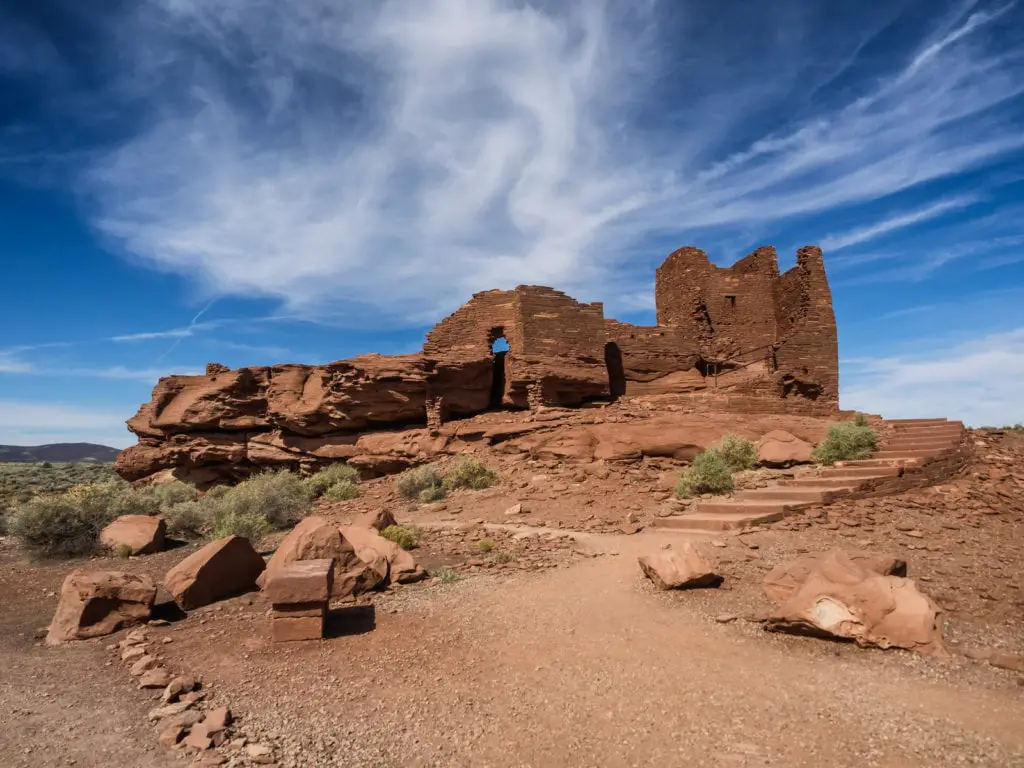Arizona is a state rich with natural wonders. From the Grand Canyon National Park to the Sonoran Desert, every corner of Arizona has a new landscape to be explored, a new view to be seen, and a new canyon to be climbed. This holds true in its national parks, environments, and national monuments.
One unique national monument is Wupatki National Monument, located in north central Arizona near Flagstaff. Known as the “landscape of legacies,” Wupatki National Monument is an ancient Pueblo settlement situated between the Ponderosa highlands and the Painted Desert.
This enchanting national monument is a great stop on your next Arizona vacation, so take a moment to browse through the need-to-knows:
- What Wupatki National Monument is known for
- Top spots/hiking information
- Camping information
- Where to stay

1. What is Wupatki National Monument known for?
As it isn’t as well-known as Arizona’s other destinations, you’re probably wondering what exactly Wupatki National Monument is known for. Don’t worry, because we’re here to help!
Ancient Ruins
In various places in Arizona, it’s possible to see ruins of ancient villages, called pueblos. Places like Montezuma National Monument, Casa Grande Ruins, and Tonto National Monument all have sites with ancient houses or ruins preserved. The difference between them and Wupatki National Monument, however, is that at most sites there is only one building or house still standing.
Wupatki National Monument is home to a village of ruins, scattered through the beautiful desert landscape. This national monument gives visitors a chance to experience Puebloan ruins in a new, authentic way. Instead of just seeing one building, you can actually imagine what it was like when people lived there once upon a time.
Wupatki National Monument was established in 1924 by President Calvin Coolidge, in an effort to preserve Wupatki and Citadel pueblos (villages). Since then, the boundaries of the monument have changed a bit — mostly in expansion to include more pueblos and other archaeological findings.
Archaeologists believe that the buildings, or dwellings, were erected by the Sinagua and Anasazi peoples in the 12th and 13th centuries. There are 800 identified ruins spread out over Wupatki National Monument’s 55 square miles. Luckily, the six sites that are open to visitors are close to the main road; these are also six of the largest sites in the national monument. Keep reading for more information on these sites.

2. Top Spots/Hiking Information
Top Spots
We recommend you try to see at least two or three of the top spots listed below. These are the only spots available for visitors to see, due to an effort to preserve the dwellings:
- Wupatki Pueblo: 104 room pueblo with a ball court and geological blowhole. This was once a Puebloan regional center for trade.
- Wukoki Pueblo: A structurally and locationally unique pueblo built on a sandstone outcrop.
- Lomaki & Box Canyon Pueblos: Pueblos located on the edge of a small canyon, uniting the human and geological stories of the Wupatki Basin:
- Nalakihu & Citadel Pueblos: Pueblos allowing for 360-degree views of the landscape.
Hiking Information
You can access each of the sites above through a guided hike. Unguided/backcountry hiking is not available anywhere in Wupatki National Monument at the moment. Here is some important hiking information:
- Wupatki Pueblo Trail:
- Distance: 0.5-mile round-trip hike
- Time: 30 to 60 minutes
- Accessible to a certain point
- Trail Level: Easy
- Wukoki Pueblo Trail:
- Distance:0.2-mile round-trip hike
- Time: 15 minutes
- Accessible to a certain point
- Trail Level: Easy
- Lomaki & Box Canyon Pueblos:
- Distance: 0.5-mile round-trip
- Time: 30 minutes
- Not accessible
- Trail Level: Easy
- Nalakihu & Citadel Pueblos:
- Distance: 0.2-mile round-trip
- Time: 15 minutes
- Nalakihu Pueblo trail accessible
- Trail Level: Easy
Longer Guided Hikes
Additionally, Wupatki National Monument offers longer guided hikes in the winter. These range in distance, time, and trail level — they can be as short as one hour and as long as a few days! If you’re an avid hiker, you should consider visiting the monument in the wintertime so you can take part in one of these hikes.
Hikes are limited in size in order to preserve the land as best as possible; maximum group size is 12 and you must make a reservation in advance. You can peruse the available hikes and all of the details on the National Park Service’s website.
If the explorer in you needs to stray from a guided hike, do not fret! The Coconino National Forest is next door to Wupatki National Monument and has a variety of unguided hikes ranging from short, easy ones to multiple-day backpacking trips.
3. Camping Information
There is no camping in Wupatki National Monument, but there is camping available close by! If you would like to camp, head on over to Coconino National Forest, where various camping locations are available near Wupatki National Monument.
Here are some of our recommended sites:
- Bonito Campground
- Lockett Meadow Campground
- O’Leary Group Campground
- Cinder Hills OHV Dispersed Camping Area
4. Where to Stay
If camping isn’t your thing, you have no need to worry. Wupatki National Monument is located just an hour away from the bustling Flagstaff, so you have plenty of accommodation options when there.
There are so many accommodation options in Flagstaff, you’ll have trouble deciding which is best! Known for its resorts, Flagstaff is also home to hotels, guest ranches, and bed and breakfasts. If you’re looking to stray from the traditional lodging options, check out AirBnB and GlampingHub.
Need some recommendations? Check out our favorite hotels in Flagstaff:
- Little America Hotel Flagstaff
- Twin Arrows Navajo Casino Resort
- Club Wyndham Flagstaff
- Grand Canyon Bed and Breakfast
- Cherry Creek Lodge
- Rockin’ M Bar Ranch
- Hilton Garden Inn Flagstaff
- Noftsger Gill Inn Bed & Breakfast
5. Other Things to do in Flagstaff
If you’re going to be staying in Flagstaff, you might as well check out everything else the city has to offer.
Food
Flagstaff is home to Northern Arizona University, so it is filled with college students, retirees, and everyone in between. Lucky for you, it boasts amazing cuisine — both international and local. Here are some of our favorite restaurants that you can try out:
- Oregano’s Pizza Bistro: (Italian, Pizza)
- Cottage Place: (French)
- Coppa Café & Bistro: (European)
- Delhi Palace: (Indian)
- MartAnne’s Burrito Palace: (Mexican)
- Agave Mexican Restaurant: (Mexican)
- The Horseman Lodge: (American Steakhouse)
- Brix Restaurant and Wine Bar: (American)
- Josephine’s Modern American Bistro: (American)
- Fat Olives: (Italian, Pizza)
Activities
Flagstaff is home to a diverse array of things to do, whether you want to spend all day outside or relax in the spa.
First thing’s first, you have to see Flagstaff’s Seven Wonders. Due to its amazing location, Flagstaff is often the starting point to get to these seven “wonders” of Arizona.
- Grand Canyon National Park
- Wupatki National Monument (you already have this one crossed off, way to go!)
- Oak Creek Canyon
- Sunset Crater Volcano
- San Francisco Peaks
- Coconino National Forest
- Walnut Canyon
If you’d like to sprinkle in other types of activities, here are some of our favorites:
- Historic Downtown and Visitor’s Center
- Wheeler Park
- Museum of Northern Arizona
- Arizona Snowbowl
- Buffalo Park
- The Arboretum
- Lowell Observatory
- Meteor Crater
- Flagstaff Extreme Adventure Course
- Lockett Meadow
To learn more information about these activities and Flagstaff in general, check out our guide to Flagstaff.
Now you are more than prepared to visit both Wupatki National Monument and Flagstaff, Arizona. Whether you spend your days on a multi-day backpacking trip or take the time to visit Flagstaff and the national monument, you are sure to enjoy your visit. We can’t wait to hear how much you loved it!

